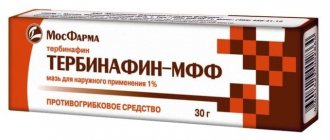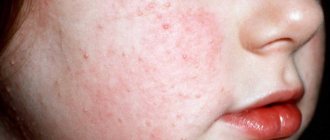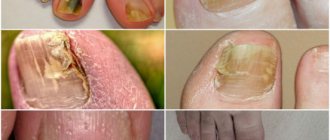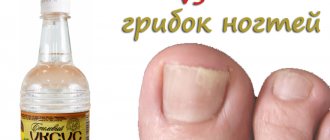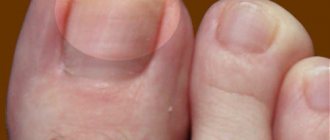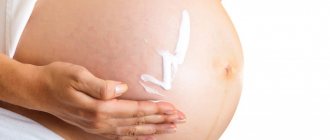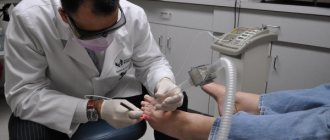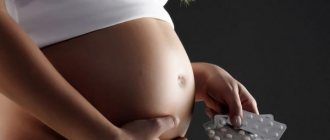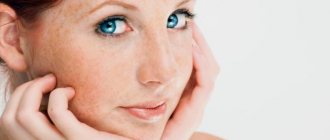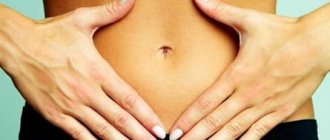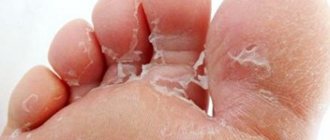17.04.2017
During the period of bearing a child, the body undergoes changes, protective forces are reduced, and there is a risk of contracting infections.
You can catch skin or nail fungus at the swimming pool, hairdresser, yoga class, or in shoe stores. Favorable conditions for fungus are created due to excessive sweating, wearing synthetic underwear or using someone else's clothes, shoes, and hygiene items.
Often the pregnant body is attacked by vaginal fungus. The main reason why yeast is found in a smear is hormonal changes.
When the level of estrogen in the blood increases, the amount of glycogen increases with it, which affects the activity of the fungus in the vagina. Another reason that causes fungus during pregnancy is poor environment, constant stress, improper daily routine and diet, long-term use of antibiotics or hormonal drugs.
The fungal pathogen causes discomfort in the mother, but does not directly harm the child. The harm of the fungus is that it lowers the immune system, increasing the risk of contracting various infections. If a pregnant mother has a fungus, it can sometimes lead to asthma or allergies in the baby. Fungal infections should be treated as soon as suspicions arise.
Causes
Fungal infection during pregnancy usually develops against the background of reduced immunity. This is often due to changes in hormonal levels. Due to decreased immunity, the body cannot cope with the defense against pathogenic microorganisms and becomes infected.
The following factors can provoke a fungal infection:
- hormonal changes in the body;
- lack of calcium, folic acid, magnesium, phosphorus, vitamins;
- being in public places without shoes: you can often become infected with fungus in the pool;
- wearing someone else's shoes, hosiery;
- too tight shoes made of artificial materials that do not breathe;
- neglect of personal hygiene (regular washing of hands and feet);
- mechanical damage to the skin;
- increased sweating;
- the presence of certain pathologies: dermatitis, eczema, diabetes;
- poor diet: people who abuse sweets and fatty foods are more susceptible to fungal infections.
Kinds
Pregnant women are predominantly diagnosed with fungal diseases of the vagina. The disease develops due to the active growth of opportunistic yeast-like microorganisms of the Candida family.
Types of fungal infections in women during pregnancy:
- mycosis of the skin, feet;
- onychomycosis - infection of the nail plate by pathogens;
- dermatomycosis - a pathological process that covers the skin, nails, folds on the body, and internal organs;
- keratomycosis - damage to the stratum corneum of the epithelium, hair cuticles;
- deep mycoses - the disease affects the respiratory system, skin, and brain.
Almost all fungal infections are contagious and are transmitted from a sick person to a healthy one.
Symptoms of nail fungus in pregnant women
There are three stages of onychomycosis – normotrophic, hypertrophic, atrophic:
- First, the color of the nail changes while maintaining its transparency; spots and grooves appear on it.
- At the hypertrophic stage, there is a loss of shine, deformation, thickening of the edges of the nail, and destruction may begin.
- At the last stage, atrophy and gradual destruction begin.
During pregnancy, onychomycosis usually develops quite quickly. Pathology can be suspected by the following signs:
- unpleasant sensations in the folds between the fingers, peeling of the skin in this area;
- changed color of the nail plate;
- thickened nail fold;
- itching;
- grooves and spots on the nail;
- bursting weeping blisters on the sole;
- fragility and separation of the nail plate;
- uneven edge of the nail;
- deformation;
- powdery coating on nails;
- thickening of the skin on the heels;
- corns.
Do you think that nail fungus is primarily an aesthetic problem?
Not really
Fungal infection can be localized in different ways. Based on this feature, the following forms of pathology are distinguished:
- distal, in which there is damage to the free edge of the nail plate;
- lateral, which is concentrated on the sides of the nail;
- proximal, when the posterior cushion becomes inflamed;
- total, meaning damage to the entire nail.
Description of the disease
The medical name of the pathology is onychomycosis. When infected with pathogenic microorganisms, damage to the nail plates on the hands or feet occurs. The disease is caused by several types of pathogenic microorganisms: trichophytes, dermatophytes, microsporia, molds and yeast-like fungi.
Infection most often occurs in common areas where people walk barefoot. At home, transmission of the pathogen most often occurs in the bathroom. In a humid and warm environment, scales of the pathogen from a sick family member fall on the woman’s skin.
Onychomycosis is acquired by using someone else's towel, shoes, or washcloth. A rubber mat in a shower often becomes a breeding ground for pathogenic microorganisms.
Predisposing factors to the spread of fungal infection:
- varicose veins;
- hyperhidrosis of the legs;
- endocrine disorders;
- narrow and uncomfortable leatherette shoes.
Nail fungus during pregnancy is a common pathology. The expectant mother's body is deficient in microelements and vitamins, and their deficiency reduces the body's defenses.
Spores that get on the skin actively multiply and after a few days symptoms appear: peeling and itching of the skin, maceration, redness in the interdigital spaces. More often, microorganisms first infect the toes, and the infection is transferred to the hands by the person himself.
Important! Nail fungus negatively affects the immune system, which is already weakened during gestation.
Symptoms of onychomycosis:
- dystrophic changes - roughness, stripes, furrows, layering;
- the plate becomes dull or yellowish;
- inflammation around the nail fold;
- its detachment from the bed.
If the disease is not treated in its initial stage, it progresses. This can result in complete destruction of the stratum corneum and the addition of a bacterial infection.
The following forms of onychomycosis are distinguished:
- normotrophic - the thickness of the plate remains the same, but spots and grooves appear on its surface, the color of the plate changes;
- hypertrophic – there is thickening and deformation, the nail crumbles;
- atrophic - the nail becomes brownish-gray in color, the bed is exposed.
Onychomycosis most often does not pose a danger to the fetus. Only in the case of a generalized infection is it possible for the pathogen to spread throughout the body, which happens rarely and in cases of severe immunodeficiency.
Yeast fungus during pregnancy, if it causes the disease, can spread to the mucous membranes of the genital organs. During labor, the baby may become infected, which subsequently develops oral thrush.
Important! At the initial signs of onychomycosis, the disease can be cured with local remedies. In advanced cases, systemic medications are needed, which are mostly contraindicated during pregnancy.
Diagnostics
If there is a suspicion of a fungal nail infection, a pregnant woman should immediately contact a specialist. A dermatologist deals with this problem.
Diagnostics is necessary to identify the type of pathogen, the stage of development of the pathology and a number of other features. It is also necessary to differentiate such an infection from other diseases - keratoderma, lichen planus, psoriasis, as well as nail deformities due to a lack of vitamins and various elements.
Disinfection is the key to effective treatment
Before looking for how to treat nail fungus during pregnancy, it is necessary to minimize the effect of pathogenic bacteria on the body . As soon as you realize that an infection has occurred, you must thoroughly disinfect all surfaces and tissues with which the pregnant woman has come into contact. Due to the fact that spores ripen quickly, they can settle and not manifest themselves for a long time. However, when the body is weakened, they will again begin to multiply in the human body.
Pay special attention to the cleanliness of bed linen and floors, and do not forget to thoroughly disinfect all your shoes, socks and tights. After washing, fabric items can be ironed with a hot iron to ensure that all microorganisms are killed. It is best to completely discard nylon stockings, tights and socks and purchase new ones. To get rid of fungal spores on manicure supplies, wipe them thoroughly with alcohol. After this, wrap in regular foil and place in a hot oven for 15-20 minutes.
Don’t forget to keep your home clean - treat all surfaces with a weak chlorine solution or any other disinfectant. Leave them on the surface for 10-15 minutes, then rinse with plenty of water. Be sure to throw away all rags and sponges used in the home disinfection process. To kill fungal spores in shoes, soak a cotton swab in bleach and leave it inside overnight. After this, leave your shoes on the balcony to remove the pungent smell. Treatment of toenail fungus should begin with this.
Treatment of nail fungus during pregnancy
Pharmacy products
There are many antifungal agents that can effectively cope with fungal infections. The problem is that during pregnancy, most medications are contraindicated, because their use is fraught with significant adverse reactions.
For a fungal infection, remedies are needed not only for external use, but also for oral administration. Most of these drugs are not suitable during pregnancy, as they can negatively affect the condition of the fetus.
It is acceptable to use Terbinafine tablets. This antifungal drug should be used for 6-12 weeks. Daily dose – 250 mg. It can be taken in 1 or 2 doses. An analogue of the drug is Lamisil.
Drug therapy for nail fungus in pregnant women is also based on the use of external agents:
- Lamisil. This product can be purchased in the form of a cream, gel, solution, or spray. The drug is applied to the affected areas in a thin layer 1-2 times a day. It is also necessary to treat the skin around the diseased nail. The course of treatment usually takes 2 weeks.
- Exoderid. This medication is available in the form of a solution or cream. You need to treat both the affected nail and the skin around it. Apply the product 1-2 times a day. Treatment usually takes a month. Before using the drug, you need to clean the affected area as much as possible.
- Mikozan. This product comes in the form of a varnish. It should be applied to affected nails twice a day for a month. After application, let the product dry for several minutes, just like decorative varnish. Once a week you need to clean the affected nail. For this purpose, a nail file is included with the product. At the end of the treatment course, you need to continue using the varnish. It should be applied once a day until a healthy nail grows.
- Another antifungal nail polish is Loceryl. It should be applied 1-2 times a week for six months. If the fungus is on the toenail, treatment can last up to a year. Before applying the drug, the affected surface must be cleaned and disinfected each time.
Among the products for external use for nail fungus are keratolytic plasters. These include Onychoplast, Mykosport, Nogtivit. Thanks to special impregnation, they soften the nail plate, kill fungus, and provide antiseptic treatment.
To combat fungus in pregnant women, you can use regular iodine. It should be applied after preliminary steaming of the nails. The advantage of the product is that, due to its liquid consistency, it penetrates well into the smallest cracks.
The treatment prescribed by the doctor must be completed. Even the disappearance of unpleasant symptoms does not mean that the disease has completely receded. There is a risk of relapse.
Traditional medicine recipes
During pregnancy, alternative medicine can be used to treat nail fungus. The following recipes are effective:
- Make night lotions with propolis tincture (20%). It is enough to soak a cotton pad with this product and fix it with a band-aid on the affected nail.
- Add 20 drops of tea tree oil to the foot bath. Keep limbs with affected nails in it for 15 minutes.
- Tea tree can also be used as an application, applying it to the affected nails with a cotton swab. For each nail you need to use a separate stick.
- Dilute 10 ml of ammonia in a glass of water, soak a cotton pad with this solution and apply to the affected nail. Cover with film and put on a sock. This manipulation is best done at night.
- Steam the affected nails in water with the addition of soda, dry and apply a cotton pad soaked in celandine oil. Secure with a bandage, put on a sock made of undyed material and leave for 20 minutes. Repeat for 2-3 days, 3 times a day.
- Regular garlic works well against fungus. You need to crush it, apply it to the affected nail, cover it with film and secure it with a bandage or fingertip.
- At night, you can apply a compress of kombucha to the affected nail. It is enough to attach a small piece of it to the sore spot. In the morning you will need to wash this area, dry it and remove the fragments that have come off. Afterwards treat the nail with an antiseptic.
Traditional medicine cannot replace drug therapy. Fungus is a serious disease, so it is better to take an integrated approach to treat it.
Treatment with traditional recipes
If a woman in an “interesting” position notices the manifestation of this disease, you can also use traditional methods of treatment:
- Golden mustache. The leaves of this plant need to be crushed and the resulting juice taken. It must be rubbed into the diseased nail plate, and then wrapped in cellophane and a bandage. This allows the affected area to be softened and removed easily. After each removal of part of the nail covering, the area is covered with tar purchased at the pharmacy. This technique will help fight the infection in the initial stages.
- Propolis with alcohol. To prepare the tincture, you need to take 100 grams of alcoholic liquid and 10 grams of the plant. Before applying the product, wipe the nail plate with potassium permanganate. Afterwards, the sore spot is generously covered with tincture and bandaged.
- Egg and dimethyl phthalate. You need to take 1 egg, 1 tablespoon of medicinal product and 1 teaspoon of oil, mix it all and apply it to your fingers. They need to be kept warm. Treatment is used for 4 days before bedtime.
important Traditional methods may not be effective for a pregnant woman. She shouldn't rely on self-medication. The best solution would be to consult a doctor so that he can prescribe the correct treatment.
Consequences, complications
In the event of a fungal infection, the affected nail becomes a source of pathogenic microorganisms. They further weaken the pregnant woman’s immune system and spread throughout the body.
The consequences of fungal infection can be the following:
- Spread of infection to adjacent healthy nails and skin.
- Infecting other people. Family members living in the same apartment are at risk.
- The fungus can be passed on to the child. In this case, he will have a chronic congenital pathology.
- Immune suppression increases the risk of other diseases, especially viral infections. They can be dangerous during pregnancy.
- A fungal infection means toxins enter the body. This can lead to various allergic manifestations - rash, eczema, dermatitis, bronchial asthma.
What is the danger for a pregnant woman?
When the first symptoms appear, pregnant women wonder whether its presence will affect the fetus. At first glance, everything looks harmless. But diseased nails are a source of infection. If the fungus is not treated, the microorganisms penetrate into the deep layers of the skin and then you will have to resort to antibiotics. And antibiotics, as we know, can have a negative effect on the baby, even when the mother is already breastfeeding, after childbirth.
Self-medication during pregnancy is unacceptable. At the first suspicion, you need to contact a specialist so that he can make an accurate diagnosis and then prescribe treatment. The fact is that if in a normal situation you can be treated for as long as you like, in any way, then during pregnancy everything is complicated by the undesirability of switching to antibiotics and contraindications for many traditional medicines. Therefore, the more you reduce the duration of treatment, the better, this will reduce the effect of the medications on the baby.
Prevention
It is better not to treat the disease, but to prevent its occurrence. To do this you need to follow certain rules:
- avoid injury to nails;
- in case of damage, use an antiseptic;
- use shoes in public places;
- do not wear someone else’s shoes, hosiery;
- choose comfortable shoes made from natural and breathable materials;
- if your feet sweat, use deodorant or talcum powder to treat the problem;
- treat nails with individual tools, do not forget about their disinfection;
- dry your feet thoroughly after washing;
- if one of the family members is infected, use antifungal agents for prevention.
During pregnancy, it is especially important to monitor your health and minimize the risks of various diseases. If you become infected with a fungus, you should consult a doctor who will prescribe treatment appropriate for the woman’s situation. Many medications are contraindicated during pregnancy, so the choice of medications must be approached carefully.
Reviews
Olga:
“It’s not clear where the fungus came from, but that doesn’t matter. The point is that the entire complex was used on the doctor’s recommendation. Everything was very bad and, if not for the pregnancy, antibiotics would have been prescribed. Cream, it seems, Exoderil, baths and Indian onion juice. At the final stage of treatment, we started rubbing the nail with propolis, and we finished with varnish. It was difficult. Treatment began when it became difficult to bend over, so I had to ask relatives for help. The main thing is that he was cured. And who knows where it would have led.”
Post Views: 432
